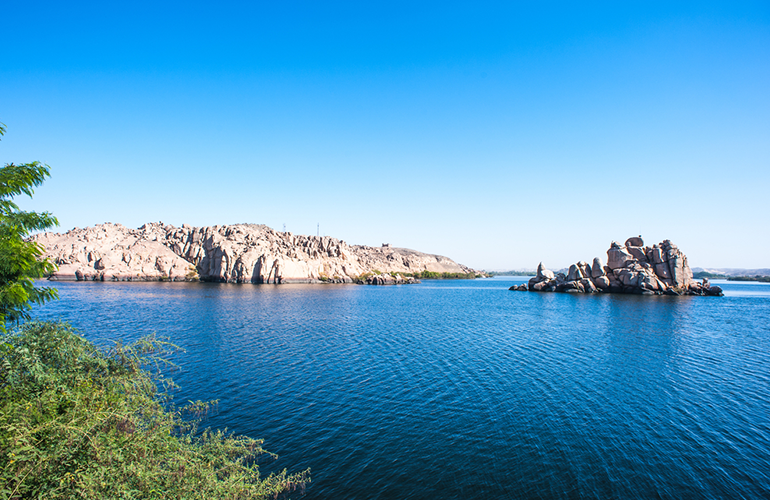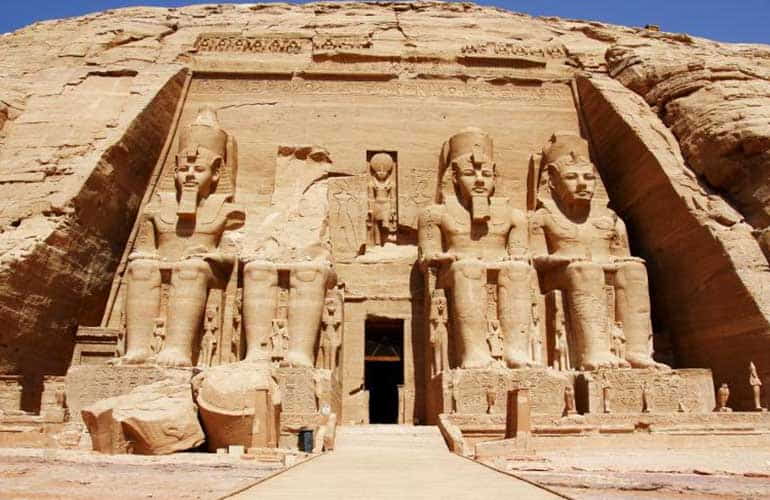Lake Nasser Facts in Egypt

Stretching south more than 500 km (310 miles) from the High Dam and reaching depths of over 180 m (590 ft), Lake Nasser is the largest artificial lake in the world.
The lake was created by the construction of the High Dam. It flooded a huge expanse of land between Aswan and Abu Simbel, the homeland of the Nubians since before Pharaonic times.
About 800,000 Nubians were displaced, many settling in Aswan, and dozens of ancient temples had to be carefully relocated.
The lake is named with ” Lake Nasser ” after the Egyptian President Gamal Abd El-Nasser Which was built the high dam during a period of wisdom for Egypt.
Crocodiles thrive in Lake Nasser, its one of the most important tourist attractions in the Lake, Crocodiles hunting is prohibited by Egyptian Law.
There are many tourist activities you can do in Lake Nasser, you can fishing in some areas of the beach or by boat ride and you can watch the ancient temples during a trip in the lake such as Kalabsha temple, Beit El Wali, Wadi El Sebou and Dakka, Amada, Kasr Ibrim, and Abu Simbel Temples.
Lake Nasser location
With a total area of 2,030 square miles, Lake Nasser is one of the largest man-made lakes in the world. Created as a result of the Aswan High Dam project, it extends along the border between Egypt and Sudan, where it is known locally as Lake Nubia. It produces much of Egypt’s hydroelectricity and is a valuable source of fresh water. For tourists, the spectacular desert landscape, abundant ancient views, and legendary fishing opportunities add to the appeal of a cruise on Lake Nasser.
The history of the Lake Nasser
Lake Nasser is named after former Egyptian President Gamal Abdel Nasser, under whose instruction the Aswan High Dam was built. The dam, which was completed in 1970, caused the floods that created Lake Nasser and confiscated the lake at its northern end. Although the Aswan High Dam increased Egypt’s hydropower output exponentially and enabled the authorities to control the annual flooding of the Nile so that arable land north of the dam could be maintained, its construction was controversial.
The creation of Lake Nasser required the relocation of some 90,000 Egyptian and Sudanese nomads; while several ancient sites (including the world-famous Abu Simbel temples) had to be moved to higher ground at great cost. Some, such as the ancient settlement of Buhen, were excavated and then abandoned to be submerged. Today the productivity of the dam is threatened by the ongoing construction of the Great Dam of the Ethiopian Renaissance, located on the border between Ethiopia and Sudan. Experts fear that the newer dam could affect the flow of water into Lake Nasser, thus reducing the electrical output of the high Aswan Dam.
Lake Nasser temples & sights
For many visitors to Lake Nasser, the ancient sites located on its shores are its greatest attraction. Of these, the most famous is undoubtedly Abu Simbel, whose great temples carved into the rock was built by Ramses II and have colossal statues that are the largest to survive from the Pharaonic era. Other highlights include the Kalabsha Temple, relocated to an island south of the High Dam of Aswan; and Qasr Ibrim, a settlement whose origins date back to the 8th century BC. The former is interesting for its combination of Egyptian and Roman iconography, while the latter is the only archaeological site in Lake Nasser still in its original location.

Although located just north of the Aswan Dam, Philae is another incredibly valuable site. Reconstructed before the floods on the island of Agilkia, the complex includes several temples, the most famous of which is the Temple of Isis. Philae rose to fame during the Ptolemaic dynasty, was dedicated to the worship of the goddess Isis and is known as one of the last bastions of the ancient religion. The sound and light show at Philae is one of the best in Egypt and should not be missed.
Other activities of Lake Nasser
There’s more to Lake Nasser than its ancient past. Its length and depth allow resident fish species to grow to unprecedented sizes, making it a pilgrimage site for serious fishermen. You can fish from the shore or from a boat, with several operators offering dedicated multi-day fishing trips.
Hiking tours in the desert around the lake give you the opportunity to visit Bedouin nomadic camps and be aware of the resident wildlife of Lake Nasser. The main sites include desert foxes
How to visit Lake Nasser?
The traditional way to experience Lake Nasser is on a cruise, with most boats leaving from Aswan or Abu Simbel taking several days to complete the journey between the two. There are several different options, ranging from luxury cruises like the 5-star Steigenberger Omar El Khayam all these activists we have in our Egypt Nile cruise tour.
If you prefer not to live on the water and the cruises, there are a handful of hotels located on the lakeside, mostly near Abu Simbel. The Seti Hotel and the Nefertari Abu Simbel Hotel are two 4-star options, both with lake views, a restaurant, a swimming pool and rooms with wireless internet and air conditioning.






